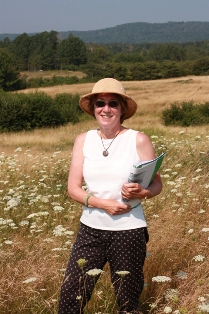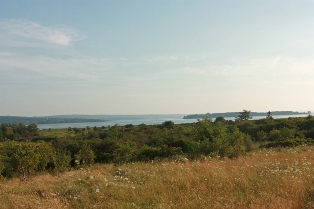Interview with an Historian: Revelations from a 17th century Acadian settlement
Melanson Settlement National Historic Site

Interview with Brenda Dunn (historian and author) by Andi Rierden for Parks Canada
Few places in North America can tell us as much about Acadian family and community life in the 17th and 18th centuries than the Melanson Settlement National Historic Site. Archaeological digs in the 1980s – aided by historic documentation – revealed ruins of a village left untouched, apart from light farming, since 1755. As historian Brenda Dunn details in a conversation below, the site emerges as a prominent and important early Acadian settlement, whose members were key in helping to create a distinct society based primarily on family kinships and a unique form of agriculture. Located on the upland overlooking the entrance to the Dauphin (Annapolis) River en route to the epicentre of government for Acadie, the settlement managed to thrive for many decades under the weight of a long and unremitting struggle for control over the region.
Before retiring from Parks Canada in 1998, Ms. Dunn served as an historian for the Nova Scotia National Historic Sites of Canada at Louisbourg, Fort Anne, Grand-Pré and Melanson Settlement. She has published widely on Nova Scotia’s colonial history and is the author of A History of Port-Royal/Annapolis Royal : 1605-1800 (Nimbus Publishing, 2004). Here are some excerpts from our conversation.
What is the link between Melanson Settlement and the Fort Anne and Port-Royal National Historic Sites?
The settlement is an important part of the larger history of European settlement in the Annapolis Royal area. It was founded by Charles Melanson and his wife Marie Dugas, following their marriage in about 1664. Marie Dugas was among the first generation of Acadians to be born at Port-Royal; her father and her maternal grandfather had settled at Port-Royal with Charles de Menou d’Aulnay in the early years of the colony. Charles Melanson arrived from England with his parents in 1657 when Acadia was under English rule. His father was a French Huguenot and his mother was English. Through his marriage into the Dugas family, Charles gained connections to many other Acadian families. In addition, Charles’ brother, Pierre Melanson, married Marguerite Mius d’Entremont and they eventually moved up to the upper Bay of Fundy and founded Grand-Pré. As their network grew, the Melansons became one of the most influential families in Acadia.
It’s important as well that the fort (present-day Fort Anne National Historic Site) was the seat of government for the region and so that had a definite impact on the Melansons economically and politically. As one example, in 1720 (a decade after the British gained control), Alexandre Robichaud, the second husband of Anne Melanson, who came from an established Acadian family and lived at the Melanson settlement, was selected as one of the first deputies to represent the Acadians in their dealings with the British government at Annapolis Royal.

Why was the Melanson Settlement so well documented very early on?
Under the French and later the British, various engineers at the fort (present-day Fort Anne National Historic Site) prepared several maps of the approach to the fort from Goat Island (formerly l’île aux Chèvres), providing a valuable record of the evolution of the Melanson Settlement and the other settlements on the lower river. No other area of Acadian settlement is so well documented.
A map drawn in 1708 by Pierre-Paul Delabat, engineer at the fort, showed the Melanson Settlement on the upland point overlooking the St. Charles’ marsh (now the Queen Anne marsh). The map shows five houses in the Melanson settlement.
The most important details on the map are the names of the occupants of the houses. Although only one name is Melanson, members of the Melanson family lived in four of the five houses. An Acadian family rarely lived in isolation; its members were related by marriage to others in the community, often in several ways.
Dotted areas adjacent to four of the houses indicate gardens where crops such as turnips, cabbages, herbs and flax would have grown. Small trees on the slope running down to the marsh belonged to the Melansons’ orchard. In the one census that included orchards, taken in 1698, Charles Melanson had 76 trees, one of the largest orchards in Port-Royal. He had the second largest amount of arable land.
The 1708 map and another drawn in 1710 provide a direct correlation between the people of the settlements along the lower river and the physical setting. We are also very fortunate that the French census of 1707 links to Delabat’s 1708 map. It is not possible to make this link for any other settlement area in pre-Deportation Acadia.
How did the Acadians evolve?
In the 1630s, Isaac de Razilly brought settlers from France to La Have. After his death, Charles d’Aulnay (Razilly’s lieutenant) moved the settlers to Port-Royal and brought new colonists from France. Under d’Aulnay, they built the first dykes, beginning Acadia’s distinctive dykeland agriculture. During the period of English rule, which lasted from 1654 to 1670, the settlers began to leave the town site and extend settlement along the Dauphin (now Annapolis) River from Goat Island, the island at the entrance to the river from the Port-Royal (now Annapolis) Basin, to above the present town of Bridgetown.
One of the earliest references to the term comes from François Du Pont Duvivier of Louisbourg. Hoping his Acadian connections would be influential in urging the Acadians to join his expedition prior to his attack on the fort in 1744, he told them, “Je suis Acadien.” By the late 17th century, these settlers had evolved into a distinct Acadian society. They were removed from France and had developed a great affinity to the land in this area.
A grass fire uncovered the Melanson site in the early eighties, which eventually led to the archaeological excavations in which you were involved as an historian. What were the overall findings?
The findings led to the conclusion that the site was not used as domestic settlement after the deportation in 1755. We have assumed that most, if not all, of the features identified date to the period of the Acadian occupation of the area. The historical record also supported this conclusion. It is the only pre-expulsion Acadian settlement that has extended ruins with detailed historical documentation.
The archaeological team uncovered quite a range of artifacts such as ceramics from England, Germany and China, scissors, coins and glass beads. This discovery added much to the understanding of the Melanson Settlement and Acadian life in the 17th and 18th centuries.
The excavations on one feature showed that four buildings had been built in succession on the same site. The first two were of picquet or vertical post construction and the second two of charpente, heavy timber framing with clay and marsh hay fill, built on a fieldstone foundation. The charpente houses both had a substantial fireplace and an exterior bake oven on the west wall. The first of these two houses had lead-camed windows - one caming was stamped with the date 1740. Bake ovens and a similar cycle of rebuilding were also found in excavations at Belleisle, further up the river.
Prior to the Deportation, how did the battles between the British and the French impact the daily life of the Melanson settlement?
It was very stressful for people living on the lower river because of all the expeditions anchoring off Goat Island. The settlement was the first Acadian settlement that came into view as vessels sailed up the Dauphin, now Annapolis, River after passing through the channel on the north side of Goat Island, at the entrance to the river from the Port-Royal, now Annapolis Basin. On at least five occasions while Acadia was under French rule, enemy fleets anchored off Goat Island, near the Melanson Settlement. On a few occasions, raiders burned Acadian buildings and killed their livestock.What happened to the Melansons after the Deportation?
During the Deportation, most of the residents were put on the Pembroke destined to go to North Carolina. Charles Belliveau, who had grown up in the Melanson Settlement, and others managed to overpower the crew and took the ship to the St. John River. From there, most of them made their way to Quebec. Subsequently some died from a smallpox epidemic including Charles Melanson and his brother Ambroise and Ambroise’s wife, Marguerite Comeau. Both men were elderly. Two years after the Deportation, a British officer described the scene along the lower river as he approached Annapolis Royal with Acadian villages in ruins, with large numbers of pear and apple trees bending under the weight of their unpicked fruit.
What do you want visitors to the site to come away with?
I want them to come away with a sense of place and an understanding of the history of the Acadians who settled along the Dauphin River (now Annapolis) and undertook a form of dykeland agriculture unique in North America. The settlement is a distinct example of Acadian settlement before the Deportation and links to the wider history of French and British colonization in the 17th and 18th centuries.
- Date modified :